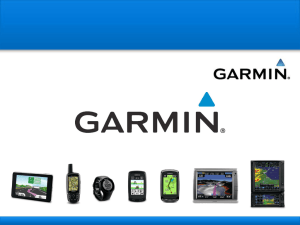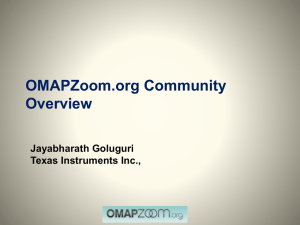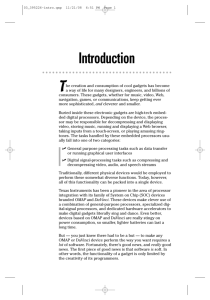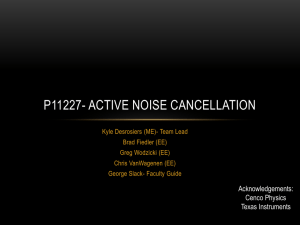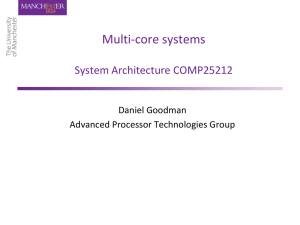View File - UET Taxila
advertisement
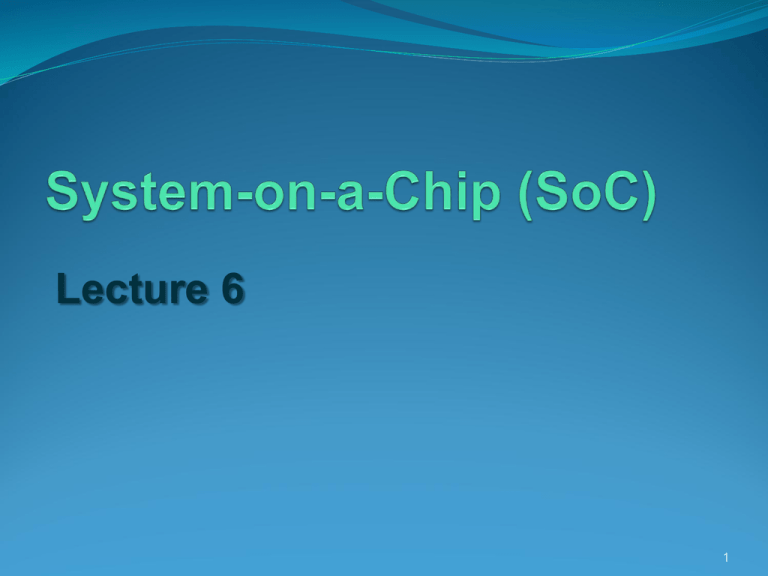
Lecture 6 1 SoC (System On a Chip) The electronics for a complete, working product contained on a single chip Complex functionalities that previously required heterogeneous components to be connected on a PCB, are integrated within one single silicon chip 2 SoC: Evolution Technologies implementing embedded systems evolved from micro-controllers and discrete components to fully integrated SoCs Reason: advances in silicon process technology enabling a complete system to be designed into one or few integrated devices Space and Power reductions Increased Performance 3 Features of SoC Typically SoC incorporates A programmable processor On-chip memory Accelerated Functional Units (e.g., Digital Encryption Standard block, MPEG2 decoder) Peripheral devices Often mixed technology designs integrating Analog, RF Components Micro-electro-Mechanical Systems (MEMS) Optical input/output 4 SoC Design Time and design effort required to integrate different types of components on a chip: a bottleneck for SoC evolution Design reuse to reduce time to market Use of parts from previous designs Making use of parts designed by third parties Hardware and Software component model! All for PROVEN and tested solutions, avoiding redesign and re-verification of real-time hardware and real-time software 5 SoC Design Flow (traditional) 6 SoC Design Cycle Requirements capture Sign-off Global testing (Initial) specification Architectural division IP component reuse Integration Component design / programming Component testing libraries Implementation 7 Simulation models Sometimes physical prototypes, sometimes software approximation of desired system Very helpful for: Tuning the specification (runs faster than full implementation) Predicting the system’s behavior and suggesting tests Performing crude early analysis of performance and dimensioning But: No relation guaranteed between simulation and further implementation Not meant for code production Formalisms: Matlab/Simulink, SystemC/C++,… 8 SoC Design Abstractions ESL Design User functional level description C/C++, SystemC + TLM, Simulink, Matlab, UML. RTL Design Converts user specification into register level description. Describes exact behavior of the chip, with I/O cxns. Verilog, VHDL, SystemC(!) Physical Design Takes the RTL + library of available logic gates Defines places for gates + wires them 9 IP-based Design Intellectual Property Cores Parameterized components with standard interfaces facilitating high level synthesis Cores available in three forms Hard Black-box in optimized layout form and encrypted simulation model. Example: microprocessors Firm Synthesized netlist which can be simulated and changed if needed Soft Register transfer level (RTL) HDLs; user is responsible for synthesis and layout 10 Platforms Embedded Applications built using Common architectural blocks and Customized application specific components Common architectures Processor, memory, peripherals, bus structures Common architectures and supporting technologies (IP libraries and tools) together called as platforms or platform-based designs Latest trend in the Embedded Systems 11 Platform-based SoC Platform-based SoCs are systems embedded on a chip that contain IP blocks like embedded CPU, embedded memory, Real-world interfaces (e.g., PCI, USB), Mixed signal blocks and Software components Device drivers, real-time operating systems and application code 12 Classes of Platforms 1. Full Application Platforms Platforms that let derivative product designers create applications on top of hardwaresoftware architectures A set of hardware modules Example: Complex dual processor architecture with hierarchical bus system tailored to a specific product’s requirements A layer of firmware and driver software Examples: Philips’ Nexperia, TI’s OMAP 13 Classes of Platforms (2) 2. Processor Centric Platforms Typically centered on specific processors Key software services like real-time OS kernel made available through libraries Examples: ARM Micropack, ST Microelectronics ST100 3. Communication Centric Platforms Communication fabric optimized for specific application Fabrics often bundled with specific processors Examples: ARM AMBA, IBM CoreConnect bus architecture 14 Classes of Platforms (3) 4. Configurable (Programmable) platforms Programmable logic added to the platform allows consumers to customize using both hardware and software Field programmable gate array (FPGA) added to hard-coded processor centric platforms Examples: Altera Excalibur platform with ARM cores, Xilinx Vertex II Pro 15 Multi-processor SoC (MPSoC) Full application platform Multiple processors CPUs, DSPs, etc. Hardwired blocks Mixed-signal Custom memory system Lots of software 16 Philips Nexperia Also a full application platform Multimedia applications: set-top box, etc. 2 CPUs, 3 busses, several accelerators, I/O devices. 17 Assignment 18 Philips Nexperia 19 TI OMAP Targets communications, multimedia. ARM11 + VFP TMS320C55x DSP Multiprocessor 2D/3D Graphics Accelerator Imaging & Video Accelerator (IVA) Memory Controller Internal SRAM Peripherals Security Camera I/F LCD I/F Video Out L4 Interconnect L3 Interconnect with DSP, RISC OMAP2420 20 ST Nomadik Targets mobile multimedia. A multiprocessor-of-multiprocessors. 21 Open Multimedia Applications Platform 22 OMAP OMAP Application processor has a dual- core architecture: ARM9 + TMS320C55 OMAP design chain includes Software IPs: OMAP supports several RTOS’s to suit different applications Application and Middleware: Ported applications and middleware like MPEG4 decoding and audio playback 23 Design Chain for OMAP 24 OMAP Hardware Architecture 25 OMAP Hardware Architecture ARM RISC core is well suited for control code (OS, User Interface, OS applications) DSP best suited for signal processing applications like video, speech processing, audio Power efficient because signal processing task on DSP consumes much less power than on ARM 26 Example Application Video-conferencing C55x DSP can process in real-time full video conferencing application (audio and video at 15 images/sec) using only 40% of the available computational capability Can manage other applications concurrently ARM processor can handle OS operations and other OS applications (may be Word, Excel, etc.) Less power consumption on the whole 27 Peripherals Includes numerous interfaces to connect peripherals or external devices from either the DSP or GPP Some interfaces Camera and Display interface Serial unidirectional compact camera port, 8-bit parallel interface, 8/16 bit bi-directional display interface, OMAP internal LCD controller Several Serial interfaces SPI, McBSP, I2C, USB, UART 28 Software Architecture Defines an interface scheme that allows GPP to be the system master Called the DSP/BIOS Bridge DSP/BIOS Bridge provides communications between GPP tasks and DSP tasks High level application developers use a set of DLLs and drivers 29 OMAP2 Includes multiple engines executing multiple tasks An ARM 11 based microprocessor runs the OS and performs supervisory control DSP core focuses on audio codecs, echo cancellation and noise suppression 3D graphics engine enables sophisticated graphics rendering Video/imaging accelerator handles streaming MPEG4 video and mega-pixel resolution camera Digital baseband processor implements network communications as a cellular modem handling voice and data 30 OMAP 2 Architecture 31 OMAP2 All blocks operate simultaneously No degradation in quality of any service Devices remain highly responsive To conserve power each of these subsystems can be shut down when not used SoC suited for implementation of Smart Phone 32 Digital Media Processor Functionalities expected in a portable media system Live preview: Capture, process, display Live video capture: Compresses Live image capture: Compresses Live audio capture: Compresses Video decode/playback Still image decode/display Audio decode/playback Photo printing Several of these modes operate concurrently 33 DM 310 Media Processor Four subsystems: imaging/video, DSP, coprocessor, ARM core Imaging/Video system: CCD controller, preview engine, onscreen display, video encoder DSP: TMS32054X operating at 72MHz (Max.) performs bulk of audio/image/video processing operations Co-processors: SIMD engine (8 or 16 bit), Quantization, Variable length coder working concurrently ARM Core: manages system level tasks, controls all components on chip except DSP and its co-processor 34 TMS320DM310 Architecture 35 Application: Still Camera Engine 36 37 Configurable SoC Consisting of Processor Memory On-chip reconfigurable hardware parts for customization to application Towards application specific programmable products 38 FPGA-based RC Programmable fabric that can be dynamically reconfigured Mapping to FPGA Only the time consuming computations are mapped Computation expressed in HDL Structure FPGA + Memory 39 Programmable Platforms Several products incorporate microprocessor and FPGA on one chip 40 Triscent A7 SoC CSL: performs basic combinational and sequential logic functions 41 Configurable processors Configurability: Processor parameters (cache size, registers, etc.) Instructions Result: HDL model for processor. Software development environment. 42 Summary We have learnt about SoC. Understood the design process of SoCs. Overviewed various types of platforms Looked at OMAP in some detail Got an introduction to the concept of reconfigurable computing & ASIPs. 43
